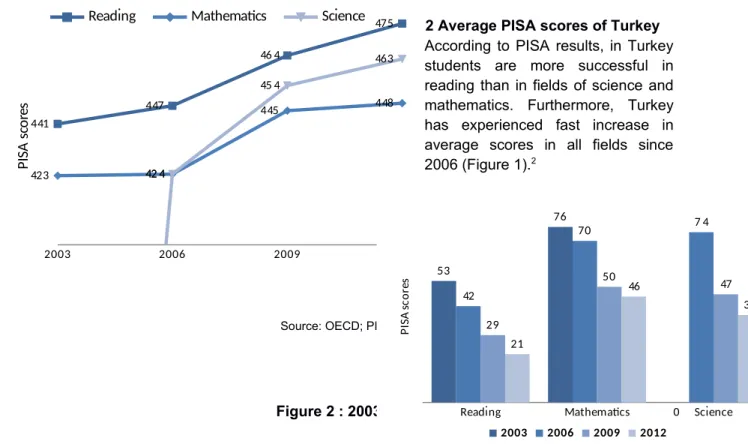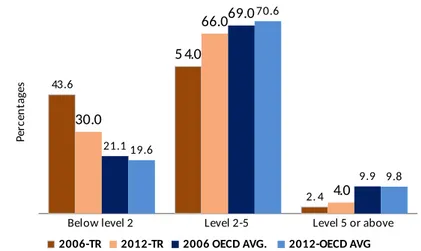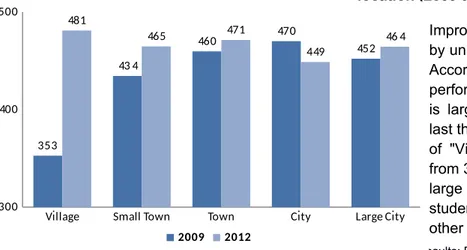LARGE BUT INSUFFICIENT INCREASE IN QUALITY OF EDUCATION
Seyfettin Gürsel* and Mine Durmaz **
Executive Summary
2012 Report of Programme for International Student Assessment (PISA) has been published in December, 2013. Results reveal that there is a large but insufficient improvement in Turkey's performance. From 2006 to 2012 Turkey increased its average score in all fields (mathematics, science and reading) from 432 to 462 points. However, this large increase has not been enough to change Turkey's ranking (third to last) among 34 OECD member countries. The gap between Turkey and OECD average has been diminished gradually in each field, yet student performances are still poor compared to OECD averages.
On the other hand, during the period of 2006-2012, Turkey increased the share of top performers and simultaneously reduced the share of low performers. In parallel, the share of medium performers, who constitute the main part of the future labor force, also increased. Turkey's large performance increase results from the success of village schools and the success of relatively poor students. In this sense, results show that inequality in education has decreased in Turkey but the level of inequality is still quite higher than that of OECD average.
Turkey is the country with the fastest increasing performance
Organization for Economic Co-operation and Development(OECD) coordinates a triennial education survey called Programme for International Student Assessment (PISA) since the year of 2000. PISA surveys aim to evaluate the 15-year-old students' skills and knowledge in science, mathematics and reading, and simultaneously provide detailed information about family background and school environment.1 In this sense, PISA surveys let researchers compare student performances at the
international level and assess outcomes of worldwide education systems. Also, these surveys provide data required to evaluate strengths and weaknesses of education systems.
The latest report of PISA (2012) has been published in December, 2013. More than 510 thousand students, representing 28 million students globally took part in PISA 2012 surveys and they cover 65 countries including 34 OECD member countries. In Turkey 4848 students participated in the 2012 survey. On the other hand, Turkey takes part regularly in PISA studies since 2003. According to reported PISA 2012 results, Turkey improved average PISA scores drastically compared to previous PISA studies. Despite large increases in PISA scores, ranking of Turkey among OECD countries has not changed. Still Turkey is third to last among them. However, the gap between Turkey and countries ranked above Turkey has significantly decreased.
**Prof. Dr. Seyfettin Gürsel , Betam, Director , seyfettin.gursel@bahcesehir.edu.tr
****Mine Durmaz, Betam, Research Assistant, mine.durmaz@bahcesehir.edu.tr 1 Turkey PISA 2012 National Report by Ministry of Education.
http://yegitek.meb.gov.tr/meb_iys_dosyalar/2013_12/13053601_pisa2012_ulusal_n_raporu.pdf
22 January 2014
According to PISA results, in Turkey students are more successful in reading than in fields of science and mathematics. Furthermore, Turkey has experienced fast increase in average scores in all fields since 2006 (Figure 1).2
The largest increase (39 score points) was recorded in the field of science. However, performance improvement at the national level did not avoid falling behind the OECD average. As can be observed in Figure 2, 2012 PISA scores are 46, 38 and 21 points below OECD averages in the fields of mathematics, science and reading respectively. Moreover, we observe that gap between Turkey’s performance and the OECD average diminished gradually during the period 2003-2012 (Figure 2). Since, according to the OECD, 40 PISA points are equivalent to one year of schooling, the result can interpreted that in 2012, students in Turkey are still one year of schooling behind their international peers in OECD countries.
During the period 2006-2012 Turkey is the fastest improving country among 34 OECD countries (Figure 33) and the annual increase in Turkey's PISA score is approximately 5 points. With respect to
the 2006 PISA average scores, Turkey, Chile, Israel and Mexico are low performers compared to rest of OECD countries. Even though the 2006 PISA scores of Chile, Mexico and Turkey are close to each other, Turkey's annual increase in average performance is quite large compared to that of Mexico and Chile. On the other hand, 12 OECD countries have experienced decline in average PISA scores, especially Sweden has the largest decrease in PISA scores.
As mentioned above, Turkey's improvement in performance in the last six years and also gradually diminishing gap with OECD average
are not enough to change Turkey's ranking among OECD countries.
Turkey needs to do more to narrow education quality gap with developed OECD countries.
2 In PISA 2006, the science framework changed. Thus, it is not possible to compare 2006, 2009 and 2012 PISA science scores with those in 2000 and 2003. In the rest of research brief, assessments in the field of science are done by using the data from 2006 PISA.
3 Distribution of average scores by proficiency levels is reported for each field. Percentages in Figure 3 refer arithmetic average of all three fields (mathematics, science and reading).
Figure 1: 2003-2012 Average PISA scores of Turkey
Figure 2 : 2003-2012 Gap in PISA scores between OECD average and Turkey
Source: OECD; PISA 2012 Results
Source: OECD; PISA 2012 Results
Note: Positive values imply that Turkey scores are less than OECD averages.
2003 2006 2009 2012 441 447 464 475 423 424 445 448 424 454 463
Reading Mathematics Science
P IS A s co re s
Reading Mathematics Science
53 76 0 42 70 74 29 50 47 21 46 38 2003 2006 2009 2012 P IS A s co re s
Inequality in education is still high compared to OECD average
Students are categorized into six proficiency levels with respect to PISA scores. Moreover, students who scored lower than the upper limit of second proficiency level are considered as low performers and students who scored higher than the lower limit of Level 5 are considered as top performers in PISA surveys. As stressed by the OECD, the proportion of top performers in total students is important because these students provide top level human capital required for economic development. In Turkey the share of top performers expanded from 2.4 percent (2006) to 4 percent (2012). These ratios are quite low compared to the OECD average (9.8 percent). On the other hand, the share of low performers in total students decreased from 43.6 to 30 percent. However, it is still above the ratio of OECD average at 19.6 percent (Figure 4).
The expansion in the proportion of medium performers (at second, third and fourth level), which are going to be the main part of future labor force, is striking. The share of medium performers increased from 54 percent (2006) to 66 percent (2012), almost catching up with the average share of medium of the OECD (70.6 percent).
According to the results of PISA, female students are better at reading and science than male students. Particularly, gender difference in reading performance is almost equal to one year of schooling. On the other hand, male students are performing better in mathematics than their female peers (Figure 5).
Figure 3 : 2006-2012 Annual Changes in PISA scores (OECD Countries)
Source: OECD; PISA 2012 Results
400 450 500 550 -4 -3 -2 -1 0 1 2 3 4 5 6 -1.24 -0.31 -0.20 -1.21 0.96 -0.29-0.49 1.75 1.17 1.72 0.26 -0.97-1.52 1.09 4.88 3.50 3.82 0.10 0.73 1.44 -0.33 -2.55 1.51 3.37 2.85 -1.74 -1.17 2.19 -3.70 0.82 5.11 0.12 0.50
2006 Average PISA scores
A n n u al c h an ge s in P IS A s co re s
Large increase in performance of poorer students
The average student performance by socioeconomic status in Turkey shows that average performances in all socioeconomic groups increased compared to the average performances in 2003.4 The largest
increase (86 score points) has occurred in the poorest quintile (Figure 6). 5 However, the expansion
in the highest socioeconomic group is limited to 25 PISA points.
Figure 6: Turkey Socioeconomic Status and
Average Student Performance
1 2 3 4 5 387 405 420 443 511 408 435 451 467 514 443 463 488 503 536 2003 2009 2012
Socioeconomic Index Quintiles
A ve ra ge P IS A s co re s
Source :The World Bank
The performance increase of students in Turkey since 2003 stems from mainly success of students in lower socioeconomic groups. Even though this progress narrowed the inequality between socioeconomic groups, the level of inequality is still large. The difference in scores between the poorest and richest quintile, which was 124 PISA points in 2003, decreased to 91 points in 2012. In other words, students in the lowest socioeconomic quintile are still 2 years of schooling behind their peers in highest quintile in 2012.
Students at villages and small towns are more successful
4Socioeconomic status refers to PISA economic, social and cultural index (ESCS). Since there is no direct household income variable in PISA datasets, ESCS index is calculated using available variables related to family background and living environment. Components of ESCS index are occupational status of parents, educational level of parents and availability of home possessions.
5 The data is taken from the research note titled "PISA 2012's success story: Improvements in Quality and Equity in Turkey's Education System" by the World Bank. (http://blogs.worldbank.org/futuredevelopment/pisa-2012-s-success-story-improvements-quality-and-equity-turkey-s-education-system )
Source: OECD; PISA 2012 Results
Source: OECD; PISA 2012 results
Note: Positive values implies that girls have better performance than that of boys
Figure 5: Turkey gender gap in PISA Scores (2006,2009 and 2012)
Figure 4: Distribution of students by proficiency levels
(2006 and 2012)Reading Mathematics Science
44 -6 12 43 -11 12 46 -8 11 2006 2009 2012 P IS A s co re s
Below level 2 Level 2-5 Level 5 or above 43.6 54.0 2.4 30.0 66.0 4.0 21.1 69.0 9.9 19.6 70.6 9.8
2006-TR 2012-TR 2006 OECD AVG. 2012-OECD AVG
Pe rc en ta ge s
PISA datasets also include detailed information on units of residence.6 The distribution of schools,
which participated ın PISA 2009 and 2012, by units of residence is as follows: 2-3 percent "village", about 10 percent "small town", 28-31 percent "town", 28-30 percent "city" and 31-27 percent "big city" (Table 2).7
Improvements in PISA performance by units of residence is unexpected. According to PISA data, average performance of students in villages is larger than that in cities. In the last three years average PISA score of "Village" schools has increased from 353 to 481 points. There was a large performance gap between students settled in villages and in other units of residence. However, in last three years this gap has
closed and also, students in villages became the most successful students (Figure 7). Average performance has risen in both towns and small towns even though the magnitude of increase is not as large as that in villages (Figure 7). As a result of performance improvements, average PISA scores of students living in smaller units of
residence have exceeded average performances in units of "City" and "Big
City". Moreover, there exists a decline (21 points) in average scores of "City". While performance is increasing in other units of residence, decrease in this category is striking.
From 2009 to 2012 Turkey's average PISA score has risen from 454 to 462 points. When this increase (8 points) is differentiated by school location, contribution of "Villages" is about 4 points, contributions of "Small towns" and "Towns" are about 3 points (6 points in total), and contribution of 4 points is coming from "Big Cities". On the other hand, 6 points decline observed in "Cities" contributed negatively (Figure 8). Especially large performance improvement in "villages" and "small towns" is an unexpected progress and needs to be explained carefully.
Appendix
Table 1: Percentages of students below level 2 and at level 5 or above by proficiency levels
Percentage of students
below level 2 Percentage of students at level 5 orabove
Mathematics Reading Science Mathematics Reading Science
Turkey 2003 52,23 36,80 38,60* 5,48 3,80 5,70* 2006 52,09 32,20 46,60 4,18 2,10 0,90 2009 42,15 24,50 30,00 5,64 1,90 1,10 2012 41,98 21,60 26,40 5,90 4,30 1,80 OECD 2003 21,50 19,20 17,90 14,60 8,20 17,60
6According to OECD, there are six categories with respect to units of residence. Units with inhabitants up to 3 thousand are defined as "village", with inhabitants between 3 and 15 thousands are defined as "small town", with inhabitants between 15 and 100 thousands are defined as "town", with inhabitants between 100 thousands and 1 million are defined as "city" and with inhabitants with more than 1 million are defined as "big city".
7 There are not enough observations in PISA 2003 and PISA 2006 for "village" category, thus 2009 and 2012 results are used to analyze results with respect to unit of residence.
Figure 7: Turkey's average PISA scores by school location (2009 and 2012)
Figure 8: 2009-2012 Distribution of average PISA score increase by school location
Source : OECD; PISA 2009,2012 Results; Betam
Source: OECD; PISA 2009,2012 Results; Betam
Village Small Town Town City Large City
-6.00 -4.00 -2.00 0.00 2.00 4.00 3.82 2.94 3.28 -5.96 3.86
Village Small Town Town City Large City
300 400 500 353 434 460 470 452 481 465 471 449 464 2009 2012
Average
2006 22,50 20,90 19,80 12,80 8,10 8,90
2009 22,00 18,50 17,90 12,70 7,70 8,50
2012 23,00 18,00 17,80 12,60 8,40 8,40
Note: Students below level 2 have maximum score of 407.47 and students at level 5 or above have minimum score of 625.61. * For 2003 Science scores students below level 2 have maximum score of 400 and students at level 5 or above have minimum score of 600.
Table 2: Distribution of 2009-2012 PISA schools by location
2009 2012
Village(Population less than 3.000) Turkey 2,98 2,28
OECD
Average 9,92 9,42
Small Town (Population with
3.000-15.000) TurkeyOECD 9,69 10,58
Average 21,51 20,98
Town (Population with 15.000-100.000)
Turkey 28,08 30,75
OECD
Average 33,93 34,64
City (Population with 100.000-1.000.000)
Turkey 27,95 29,82
OECD
Average 23,06 23,78
Large City (Population more than 1.000.000)
Turkey 31,3 26,57
OECD




